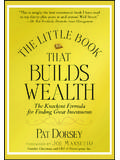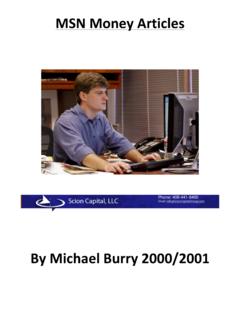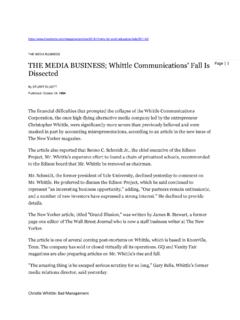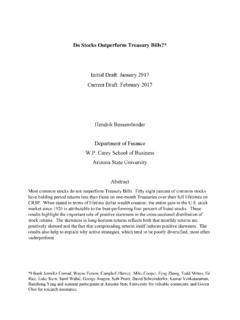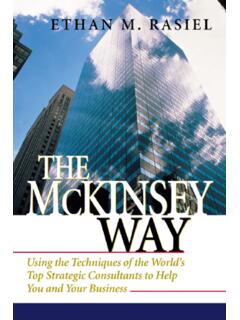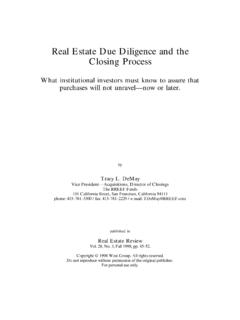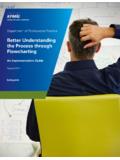Transcription of Basic Structure of Investment Process and Valuation
1 1 Basic Structure of Investment Process and ValuationProfessor Bruce Greenwald2 Value Investing Principles Identify enterprises whose value as a business is reliably calculable by you (circle of competence) Among those enterprises, invest in those whose market price (equity plus debt) is below your calculated value by an appropriate margin of safety (1/3 to 1/2)3 Value Investing ProcessSEARCH Cheap Ugly Obscure Otherwise IgnoredVALUATION Assets Earnings Power FranchiseREVIEW Key Issues Collateral Evidence Personal BiasesRISK MANAGEMENT Margin of Safety Some Diversification Patience Default Strategy45 Systematic Biases1.
2 InstitutionalzHerding Minimize DeviationszWindow Dressing (January Effect)zBlockbusters2. IndividualzLoss AversionzHindsight BiaszLotteries6 Value Investing ProcessSEARCH Cheap Ugly Obscure Otherwise IgnoredVALUATION Assets Earnings Power FranchiseREVIEW Key Issues Collateral Evidence Personal BiasesRISK MANAGEMENT Margin of Safety Some Diversification Patience Default Strategy7 Valuation Approaches Ratio AnalysisCash Flow MeasureEarnings(Maint. Inv. = Depr + A)EBIT(Maint. Inv. = Depr + A; Tax =0)EBIT - A(Maint. Inv. = Depr only)EBIT-DA(Maint.)
3 Inv. = 0)MultipleDepends on: Economic position Cyclical situation Leverage Mgmt. Quality Cost of Capital (Risk) GrowthxRange of Error (100%+)8 Valuation ApproachesNet Present Value of Cash FlowValue= CFt=CF011 + R()t1R - g * t=0 Note: NPV Analysis encompasses ratio analysis(NPVdiseases are ratio analysis diseases)Note: NPV is theoreticallycorrectRevenuesMarginsRequi red InvestmentsCash FlowsCost of CapitalNPV </> Market ValueForces:zConsumer BehaviorzCompetitor BehaviorzCost PressureszTechnologyzTechzManagement PerformanceParameters:zMarket SizezMarket SharezMarket GrowthzPrice/CostzTechzManagement PerformanceIn Practice:X9 Shortcomings of NPV Approach in Practice(1) Method of Combining Information (2) Sensitivity Analysis is Based on Difficult-to-Forecast Parameters which co-vary in fairly complicated waysNPV = CFo+CF111 + R1 + R+.
4 +CF20201+ ..Good Information (Precise)= Bad/Imprecise InformationBad Information (Imprecise)Profit MarginCost of CapitalGrowthRequired Investment10 Valuation AssumptionsTraditional: Profit rate 6% Cost of capital 10% Investment /sales 60% Profit rate +3% ( 9%) Growth rate 7% of sales, profitsStrategic: Industry is economically viable Entry is Free (no incumbent competitive advantage) Firm enjoys sustainable competitive advantage Competitive advantage is stable, firm grows with industry11 Value InvestingBasic Approach to Valuation Know what you know ; Circle of competence1.
5 Organize Valuation components by reliabilityMost ReliableLeast Reliable2. Organize Valuation components by underlying strategic assumptionNo Competitive Growing CompetitiveAdvantage Advantage12 Basic Elements of ValueStrategic DimensionGrowth in Franchise OnlyFranchise ValueCurrent Competitive AdvantageFree EntryNo Competitive AdvantageAsset ValueEarnings Power Value Tangible Balance Sheet Based No Extrapolation Current Earnings Extrapolation No Forecast Includes Growth Extrapolation ForecastReliability DimensionTotal Value13 Industry Entry - ExitRemember.
6 Exit is Slower than Value Net Asset ValueEntryChemicals$2B$1 BYes (P MV )(Allied)$ $1 BYes$ $1 BStopAutomobiles$40B$25 BYes (Sales MV )(Ford)$30B$25 BYes$25B$25 BStopInternet$10B$ ValueAssetsCashBookBookAccounts Receivable BookBook + AllowanceInventoriesBookBook + LIFOPPE0 Orig Cost AdjProduct Portfolio0 Years R & DCustomer Relationships0 Years SGAO rganization0 Licenses, Franchises0 Private Mkt. ValueSubsidiaries0 Private Mkt. ValueLiabilitiesA/P, AT, ALBookBookDebtBookFair MarketDef Tax, ReservesBookDCFB ottom LineNet Net Wk CapNet Repro ValueReproduction ValueBasic Graham-Dodd Value15 Earning Power ValuezBasic Concept Enterprise value based on this years Earnings zMeasurement- Earnings Power Value = Earnings zSecond most reliable information earnings todayzCalculation Earnings Accounting Income + Adjustments Cost of Capital = WACC (Enterprise Value) Equity Value = Earnings Power Value.
7 Current profitability is sustainable1 Cost of capital*16 Earning Power Calculation(1)Start with Earnings not including accounting adjustments (one-time charges not excluded unless policy has changed)(2) Earnings are Operating earnings (EBIT)(3)Look at averagemargins over a business/Industry cycle (at least 5 years)(4)Multiply average margins by sustainable (usually current) revenues This yields normalized EBIT(5)Multiply by one minus Averagetax rate (no pat)(6)Add back excess depreciation(after tax at average tax rate) This yields normalized Earnings(7)Add adjustments for unconsolidated subs, problem being fixed, pricing power, etc17 Earnings Power ValueEPV Business Operations = Earnings Power x 1/WACCEPV Company = EPV Business Operations + Excess Net Assets(+cash, +real estate, - legacy costs)EPV Equity = EPV Company Value DebtEPV EQUITY equivalent to AV EQUITYEPV COMPANY equivalent to AV COMPANY18 Earning Power and Entry - ExitAsset ValueEP ValueCase B:Free EntryIndustry BalanceCase A.
8 Asset ValueEP ValueValue Lost to Poor Management and/or Industry DeclineAsset ValueEP ValueCase C:Consequence of Comp. Advantage and/or Superior Management Sustainability depends on Continuing Barriers-to-Entry19 Total Value Including GrowthzLeast reliable - Forecast change not just stability (Earnings Power)zHighly sensitive to assumptionszData indicates that investors systematically overpay for growthzStrict value investors want growth for Free (Market Value < Earnings Power Value)20 Value of Growth - Basic Forces At Work Growing Stream of Cash Flows is more Valuable than a Constant Stream (relative to current Cash Flow)
9 Growth Requires Investment which reduces current (distributable) Cash CF0vs. CF01R - G*1R*WACCG rowth RateCF0= Earnings yInvestment Needed to Support GrowthNo Growth CF0( Do Not Discount Growing Earnings Streams)21 Value of GrowthQuantitative EffectsInvestment: $100 millionCost of Funds: 10% (R) = $10 MReturn on Investment (%)5%10%20%Return on Investment ($)$5M$10M$20 MCost of Investment $10M$10M$10 MNet Income Created($5M)0$10 MNet Value Created($50M)0$100 MQualitative Impact:Situation:Value DestroyedCompetitive DisadvantageNo ValueLevel Playing FieldValue CreatedCompetitive Advantage22 Earning Power and Entry - ExitAsset ValueEP ValueCase B:Free EntryIndustry BalanceCase A:Asset ValueEP ValueValue Lost to Poor Management and/or Industry DeclineAsset ValueEP ValueCase C:Consequence of Comp.
10 Advantage and/or Superior Management Sustainability depends on Continuing Barriers-to-Entry23 Valuing Growth BasicszGrowth at a competitive disadvantage destroys value (AT&T in info processing)zGrowth on a level playing field neither creates nor destroys value (Wal-Mart in NE)zOnly franchise growth (at industry rate) creates value24 Value Investing ProcessSEARCH Cheap Ugly Obscure Otherwise IgnoredVALUATION Assets Earnings Power FranchiseREVIEW Key Issues Collateral Evidence Personal BiasesRISK MANAGEMENT Margin of Safety Some Diversification Patience Default Strategy25 Consequences of Free EntryCommodity Markets (Steel)$/QQFirm PositionPriceAC Economic Profit ROE (20%) > Cost of Capital Entry/ExpansionSupply Up, Price Down$/QQFirm PositionPriceAC(Efficient Producers)

